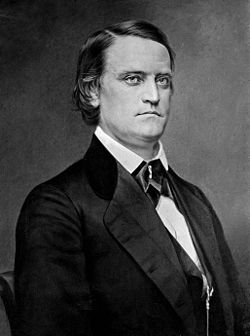Nomination
The Democratic Party's state convention was held on April 16, and was controlled by Orr's faction. The convention advocated for party unity, maintaining the union, and rejected the Alabama platform's plan to have the southern delegations walk out of the national convention. Orr served as president of the convention, which endorsed him for the presidential nomination. Muscoe R. H. Garnett communicated with South Carolinian leaders, such as William Porcher Miles, and advocated supporting Robert M. T. Hunter, Benjamin Fitzpatrick, James Guthrie, John C. Breckinridge, or Orr for the presidential nomination. An uninstructed sixteen member delegation was sent to the national convention.
South Carolina's delegation to the Democratic National Convention in Charleston included Arthur Simkins, James Simons, Thomas Young Simons, Samuel McGowan, Benjamin H. Wilson, Franklin Gaillard, and Benjamin Franklin Perry. The delegation supported Hunter during the presidential balloting. On April 30, 1860, all except for three members of the delegation (Simkins, Perry, and Lemuel Boozer) joined other southern states in bolting the convention.
A new state convention, pushed by Rhett and his supporters against the opposition of Perry and Orr, was held on May 30. Only 52 of the 161 delegates to the first convention were reelected to attend this one. Rhett, his brother Edmund Rhett, and his son R. Barnwell Rhett Jr. were among the delegates elected. John Hugh Means, who previously supported secession in 1851, was selected as permanent chairman of the convention.
The state's four at-large delegates were selected by a vote of the whole convention rather than by a committee based on the congressional districts. This system benefited the more radical and pro-secessionist delegates. Rhett was elected as a delegate to the national convention in Baltimore and was the leader of the delegation. This delegation supported the presidential ticket of Breckinridge and Joseph Lane.
This page is based on this
Wikipedia article Text is available under the
CC BY-SA 4.0 license; additional terms may apply.
Images, videos and audio are available under their respective licenses.


